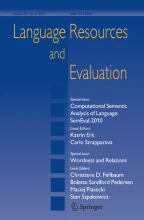Notes
“A Computer Assisted Analysis of Stephen Crane's Grammatical Style,” Dissertation, University of Southern California, 1978.
Since it is best to keep passages for analysis and comparison as much alike as possible in order to reduce the variables and make stylistic study meaningful, only narrative-descriptive passages were chosen. Dialogue and introductory or subsequent utterances related to dialogue, even if more than the minimal “he said,” were omitted; for example, from “‘Ah, what deh hell,’ he said, and smote the deeply-engaged one on the back of the head” (fromMaggie) nothing would be included. While narration and description are two distinct modes, in fiction one can rarely find a pure passage of either mode extending for any length. Narration intrudes into description or vice versa. The attempt with Crane was to select passages that went on for a bit without dialogue interruptions, starting from the beginning of the text under consideration until a sufficient data sample was selected. The works in the larger study, writing date, and word count of passages are: (1) The “Sullivan County Sketches” (mostly April and May 1892). From those narratives as a group which involve the “little man” as central character: “Four Men in a Cave,” “The Octopush,” “A Ghoul's Accountant,” “The Black Dog,” “Killing His Bear,” “The Cry of Huckleberry Pudding,” “The Mesmeric Mountain”: 3678 words. (2)Maggie: A Girl of the Streets (finished January 1893): 5022 words. (3)The Red Badge of Courage (draft, 1894): 1853 words. (4)The Red Badge of Courage (manuscript, 1894): 6780 words. (5) “The Wise Men,” “The Five White Mice,” “A Man and Some Others” (late spring or early summer 1896): 5269 words. (6) “The Open Boat (February 1897), “The Monster” (September 1897), “The Blue Hotel” (December 1897): 5727 words. (7) “The Price of the Harness” (September 1898) and “The Clan of No-Name” (October 1898): 4862 words. (8)The O'Ruddy (completed through Chapter XXV when Crane died in June 1900): 6616 words. Groups 1 through 4 constitute what I call Crane's first stage, 5 through 7 his middle stage, and 8 his last stage.
The Red Badge of Courage: A Facsimile Edition of the Manuscript, ed. Fredson Bowers (Washington, D.C.: NCR Microcard Editions, 1972 and 1973). This is the edition used for the data in this study.
The data from the holograph facsimile of the draft come from pp. 204–205; p. 208, l. 15–p. 210; p. 214; p. 222 from l. 18; pp. 232–234, l. 6. The corresponding holograph facsimile manuscript passages come from pp. 6–8; pp. 11–15; pp. 19–20, l. 10; p. 46, ll. 15–26; p. 60, l. 23–p. 64, l. 5. See Appendix A for a comparable draft and manuscript passage. References to the manuscript and draft appear in the text hereafter with page numbers in parentheses.
HAWKEYE is an updated and improved version of the computer program EYEBALL formulated by Donald Ross, Jr., and Robert Rasche in 1960 and outlined by Ross in “Beyond the Concordance: Algorithms for Description of English Clauses and Phrases,”The Computer and Literary Studies, ed. A.J. Aitken, R.W. Bailey, and N. Hamilton-Smith (Edinburgh: The University of Edinburgh Press, 1973) pp. 85–99. Professor Robert Dilligan and Lucy Hawk of the University of Southern California are responsible for the refinements in HAWKEYE.
See two letters addressed to John Northern Hilliard in January [1896?] and [1897?] in which Crane states what to him is “good writing,” in:Stephen Crane: Letters, ed. R.W. Stallman and Lillian Gilkes (New York: New York University Press, 1960) pp. 109 and 158.
The literature on this subject is vast. Noam Chomsky's work is basic and has been the catalyst for extensive research, both in support of and in opposition to his theories. Roger Brown'sA First Language: The Early Stages (Cambridge, MA: Harvard University Press, 1978) is but one example.
I adopt W. Ross Winterowd's term from “The Grammar of Coherence,”College English (May 1970) 828–835.
Stephen Crane,The Works of Stephen Crane, ed. Fredson Bowers (Charlottesville: The University Press of Virginia, 1969) IV, 59–60.
Free modifiers, a special and more sophisticated means of expanding base sentences, were first described and discussed by Francis Christense, beginning with “In Defense of the Absolute,” inCollege English, May 1950, through “A Generative Rhetoric of the Paragraph,” inCollege Composition and Communication, October 1965, for a total of six essays. All are reprinted with an introductory preface inNotes Toward A New Rhetoric, 2nd ed. (New York: Harper and Row, 1978).
InMy Stephen Crane, ed. with an Introduction by Edwin H. Cady (Syracuse: Syracuse University Press, 1958) p. 45.
Normal word order would call for something like “Reeling from exhaustion, he himself was not astonished,” but one wonders about the need for and effectiveness of the intensive pronoun.
Author information
Authors and Affiliations
Rights and permissions
About this article
Cite this article
Guinn, D.M. The making of a masterpiece: Stephan Crane's the red badge of courage. Comput Hum 14, 231–239 (1980). https://doi.org/10.1007/BF02404432
Issue Date:
DOI: https://doi.org/10.1007/BF02404432
